Detailed Lab Sheet Assignment: CBC, CMP, Lipid, Cardiac & Thyroid
VerifiedAdded on 2023/06/03
|17
|4434
|295
Homework Assignment
AI Summary
This assignment provides a comprehensive overview of various lab values, including those from a Complete Blood Count (CBC), Comprehensive Metabolic Panel (CMP), lipid panel, cardiac enzymes, and thyroid function tests. It identifies the normal values for each lab test and discusses the clinical indications for obtaining these labs. Additionally, the assignment explores conditions associated with abnormal levels (high and low) of each lab value, offering insights into the interpretation of lab results for diagnostic and monitoring purposes. The analysis covers a wide range of parameters, such as red blood cell indices, electrolyte balance, liver function, renal function, cardiac markers, and thyroid hormones, making it a valuable resource for students studying healthcare and related fields. Desklib provides access to this and similar solved assignments and past papers to aid students in their studies.
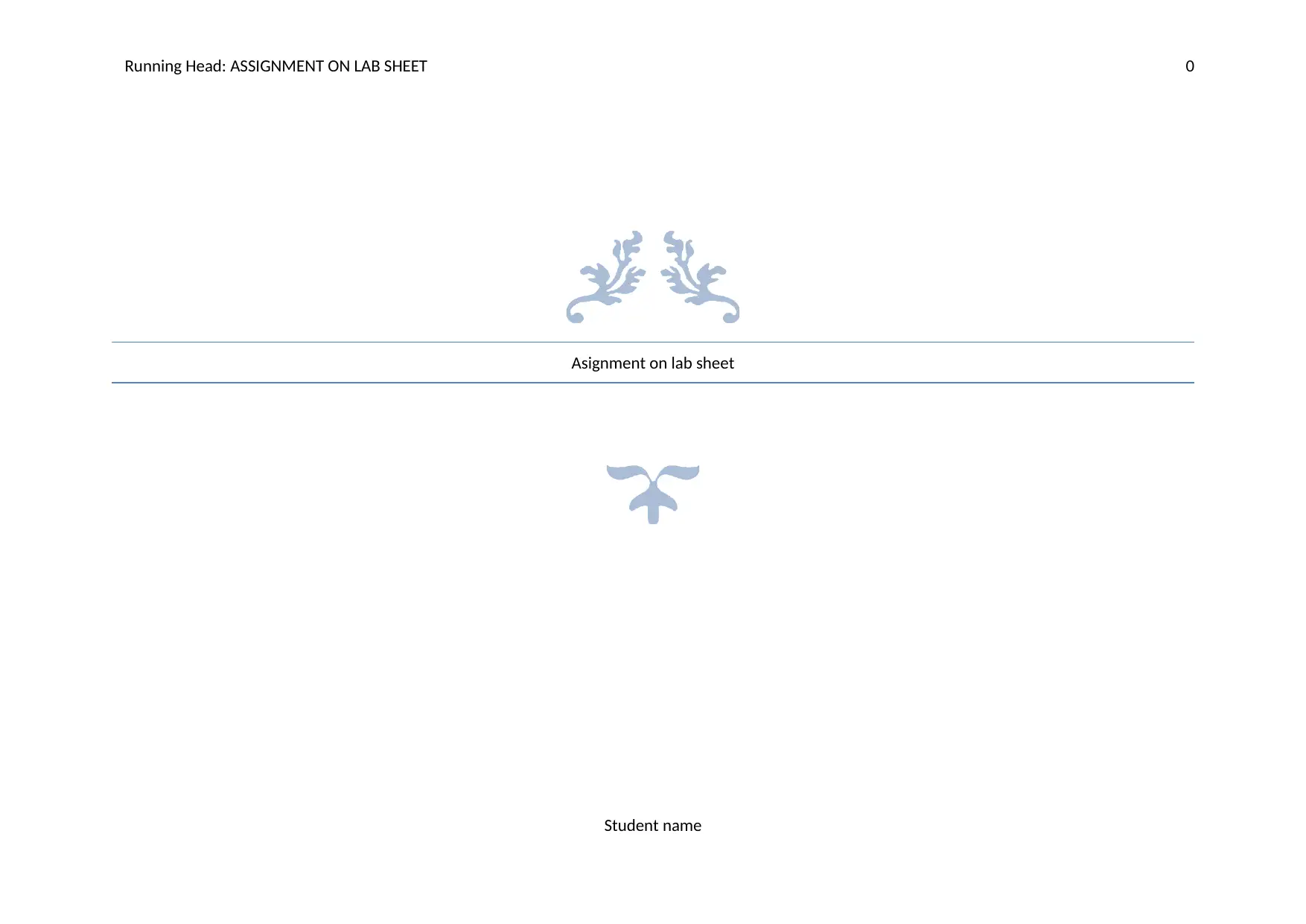
Running Head: ASSIGNMENT ON LAB SHEET 0
Asignment on lab sheet
Student name
Asignment on lab sheet
Student name
Paraphrase This Document
Need a fresh take? Get an instant paraphrase of this document with our AI Paraphraser
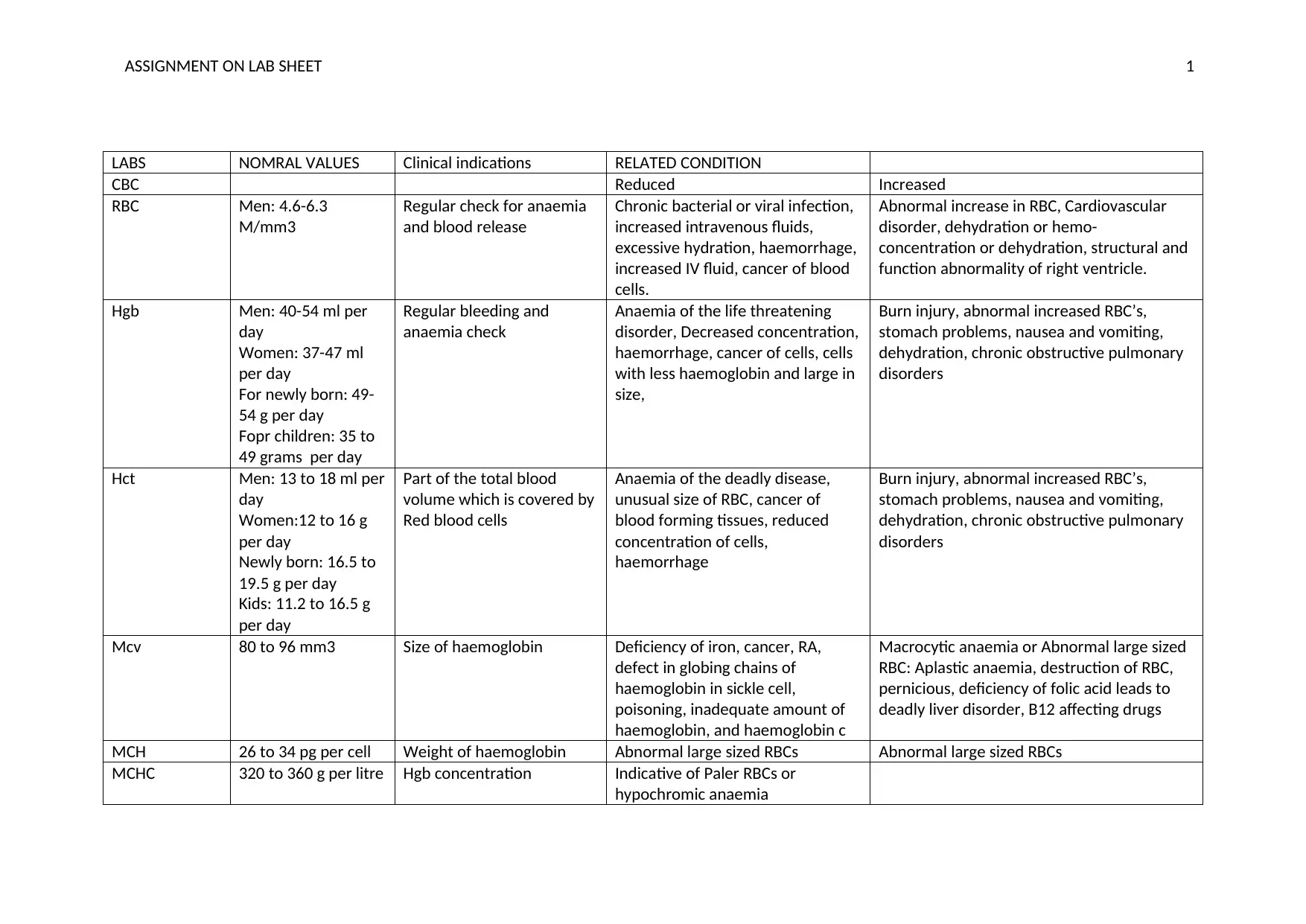
ASSIGNMENT ON LAB SHEET 1
LABS NOMRAL VALUES Clinical indications RELATED CONDITION
CBC Reduced Increased
RBC Men: 4.6-6.3
M/mm3
Regular check for anaemia
and blood release
Chronic bacterial or viral infection,
increased intravenous fluids,
excessive hydration, haemorrhage,
increased IV fluid, cancer of blood
cells.
Abnormal increase in RBC, Cardiovascular
disorder, dehydration or hemo-
concentration or dehydration, structural and
function abnormality of right ventricle.
Hgb Men: 40-54 ml per
day
Women: 37-47 ml
per day
For newly born: 49-
54 g per day
Fopr children: 35 to
49 grams per day
Regular bleeding and
anaemia check
Anaemia of the life threatening
disorder, Decreased concentration,
haemorrhage, cancer of cells, cells
with less haemoglobin and large in
size,
Burn injury, abnormal increased RBC’s,
stomach problems, nausea and vomiting,
dehydration, chronic obstructive pulmonary
disorders
Hct Men: 13 to 18 ml per
day
Women:12 to 16 g
per day
Newly born: 16.5 to
19.5 g per day
Kids: 11.2 to 16.5 g
per day
Part of the total blood
volume which is covered by
Red blood cells
Anaemia of the deadly disease,
unusual size of RBC, cancer of
blood forming tissues, reduced
concentration of cells,
haemorrhage
Burn injury, abnormal increased RBC’s,
stomach problems, nausea and vomiting,
dehydration, chronic obstructive pulmonary
disorders
Mcv 80 to 96 mm3 Size of haemoglobin Deficiency of iron, cancer, RA,
defect in globing chains of
haemoglobin in sickle cell,
poisoning, inadequate amount of
haemoglobin, and haemoglobin c
Macrocytic anaemia or Abnormal large sized
RBC: Aplastic anaemia, destruction of RBC,
pernicious, deficiency of folic acid leads to
deadly liver disorder, B12 affecting drugs
MCH 26 to 34 pg per cell Weight of haemoglobin Abnormal large sized RBCs Abnormal large sized RBCs
MCHC 320 to 360 g per litre Hgb concentration Indicative of Paler RBCs or
hypochromic anaemia
LABS NOMRAL VALUES Clinical indications RELATED CONDITION
CBC Reduced Increased
RBC Men: 4.6-6.3
M/mm3
Regular check for anaemia
and blood release
Chronic bacterial or viral infection,
increased intravenous fluids,
excessive hydration, haemorrhage,
increased IV fluid, cancer of blood
cells.
Abnormal increase in RBC, Cardiovascular
disorder, dehydration or hemo-
concentration or dehydration, structural and
function abnormality of right ventricle.
Hgb Men: 40-54 ml per
day
Women: 37-47 ml
per day
For newly born: 49-
54 g per day
Fopr children: 35 to
49 grams per day
Regular bleeding and
anaemia check
Anaemia of the life threatening
disorder, Decreased concentration,
haemorrhage, cancer of cells, cells
with less haemoglobin and large in
size,
Burn injury, abnormal increased RBC’s,
stomach problems, nausea and vomiting,
dehydration, chronic obstructive pulmonary
disorders
Hct Men: 13 to 18 ml per
day
Women:12 to 16 g
per day
Newly born: 16.5 to
19.5 g per day
Kids: 11.2 to 16.5 g
per day
Part of the total blood
volume which is covered by
Red blood cells
Anaemia of the deadly disease,
unusual size of RBC, cancer of
blood forming tissues, reduced
concentration of cells,
haemorrhage
Burn injury, abnormal increased RBC’s,
stomach problems, nausea and vomiting,
dehydration, chronic obstructive pulmonary
disorders
Mcv 80 to 96 mm3 Size of haemoglobin Deficiency of iron, cancer, RA,
defect in globing chains of
haemoglobin in sickle cell,
poisoning, inadequate amount of
haemoglobin, and haemoglobin c
Macrocytic anaemia or Abnormal large sized
RBC: Aplastic anaemia, destruction of RBC,
pernicious, deficiency of folic acid leads to
deadly liver disorder, B12 affecting drugs
MCH 26 to 34 pg per cell Weight of haemoglobin Abnormal large sized RBCs Abnormal large sized RBCs
MCHC 320 to 360 g per litre Hgb concentration Indicative of Paler RBCs or
hypochromic anaemia
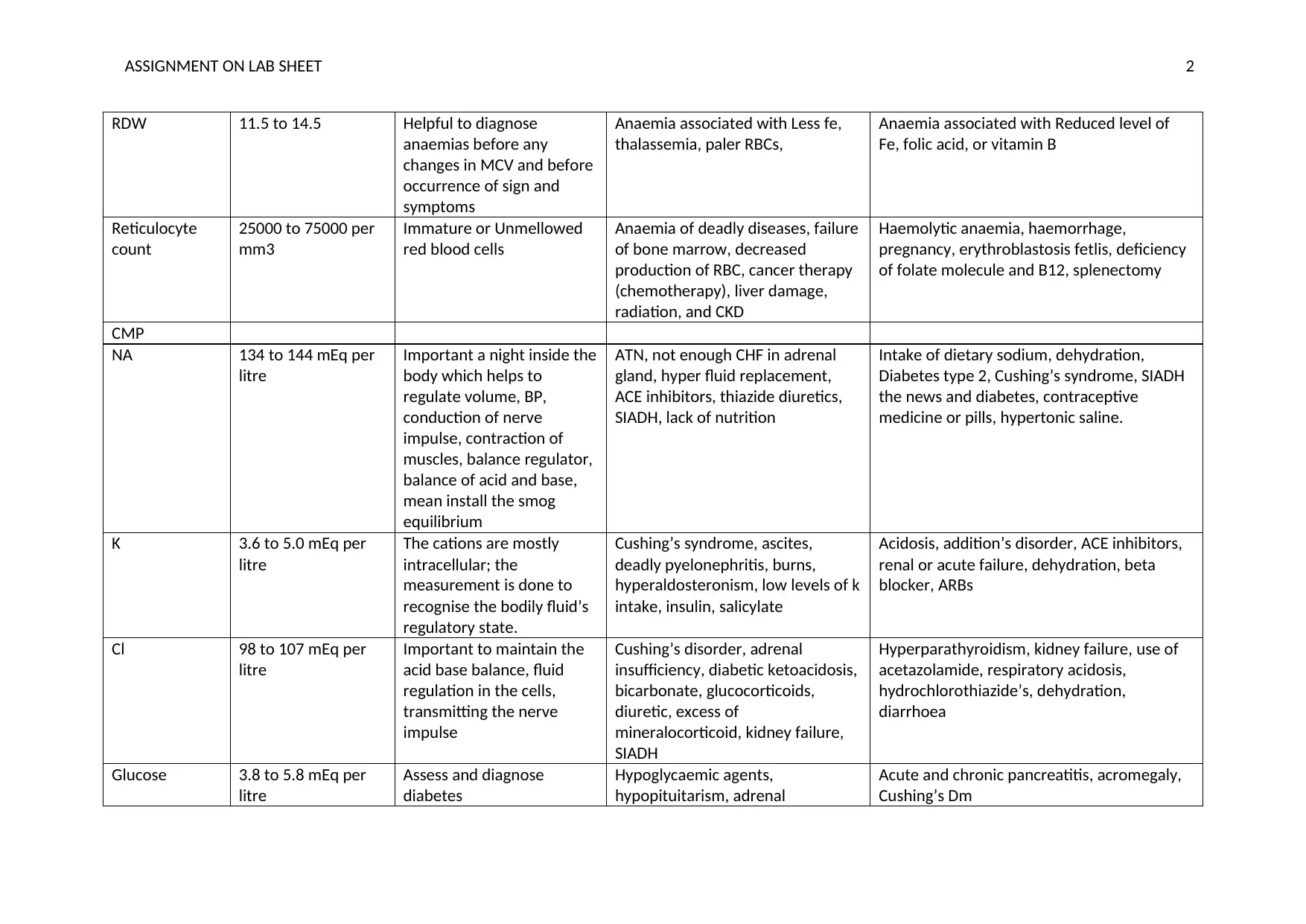
ASSIGNMENT ON LAB SHEET 2
RDW 11.5 to 14.5 Helpful to diagnose
anaemias before any
changes in MCV and before
occurrence of sign and
symptoms
Anaemia associated with Less fe,
thalassemia, paler RBCs,
Anaemia associated with Reduced level of
Fe, folic acid, or vitamin B
Reticulocyte
count
25000 to 75000 per
mm3
Immature or Unmellowed
red blood cells
Anaemia of deadly diseases, failure
of bone marrow, decreased
production of RBC, cancer therapy
(chemotherapy), liver damage,
radiation, and CKD
Haemolytic anaemia, haemorrhage,
pregnancy, erythroblastosis fetlis, deficiency
of folate molecule and B12, splenectomy
CMP
NA 134 to 144 mEq per
litre
Important a night inside the
body which helps to
regulate volume, BP,
conduction of nerve
impulse, contraction of
muscles, balance regulator,
balance of acid and base,
mean install the smog
equilibrium
ATN, not enough CHF in adrenal
gland, hyper fluid replacement,
ACE inhibitors, thiazide diuretics,
SIADH, lack of nutrition
Intake of dietary sodium, dehydration,
Diabetes type 2, Cushing’s syndrome, SIADH
the news and diabetes, contraceptive
medicine or pills, hypertonic saline.
K 3.6 to 5.0 mEq per
litre
The cations are mostly
intracellular; the
measurement is done to
recognise the bodily fluid’s
regulatory state.
Cushing’s syndrome, ascites,
deadly pyelonephritis, burns,
hyperaldosteronism, low levels of k
intake, insulin, salicylate
Acidosis, addition’s disorder, ACE inhibitors,
renal or acute failure, dehydration, beta
blocker, ARBs
Cl 98 to 107 mEq per
litre
Important to maintain the
acid base balance, fluid
regulation in the cells,
transmitting the nerve
impulse
Cushing’s disorder, adrenal
insufficiency, diabetic ketoacidosis,
bicarbonate, glucocorticoids,
diuretic, excess of
mineralocorticoid, kidney failure,
SIADH
Hyperparathyroidism, kidney failure, use of
acetazolamide, respiratory acidosis,
hydrochlorothiazide’s, dehydration,
diarrhoea
Glucose 3.8 to 5.8 mEq per
litre
Assess and diagnose
diabetes
Hypoglycaemic agents,
hypopituitarism, adrenal
Acute and chronic pancreatitis, acromegaly,
Cushing’s Dm
RDW 11.5 to 14.5 Helpful to diagnose
anaemias before any
changes in MCV and before
occurrence of sign and
symptoms
Anaemia associated with Less fe,
thalassemia, paler RBCs,
Anaemia associated with Reduced level of
Fe, folic acid, or vitamin B
Reticulocyte
count
25000 to 75000 per
mm3
Immature or Unmellowed
red blood cells
Anaemia of deadly diseases, failure
of bone marrow, decreased
production of RBC, cancer therapy
(chemotherapy), liver damage,
radiation, and CKD
Haemolytic anaemia, haemorrhage,
pregnancy, erythroblastosis fetlis, deficiency
of folate molecule and B12, splenectomy
CMP
NA 134 to 144 mEq per
litre
Important a night inside the
body which helps to
regulate volume, BP,
conduction of nerve
impulse, contraction of
muscles, balance regulator,
balance of acid and base,
mean install the smog
equilibrium
ATN, not enough CHF in adrenal
gland, hyper fluid replacement,
ACE inhibitors, thiazide diuretics,
SIADH, lack of nutrition
Intake of dietary sodium, dehydration,
Diabetes type 2, Cushing’s syndrome, SIADH
the news and diabetes, contraceptive
medicine or pills, hypertonic saline.
K 3.6 to 5.0 mEq per
litre
The cations are mostly
intracellular; the
measurement is done to
recognise the bodily fluid’s
regulatory state.
Cushing’s syndrome, ascites,
deadly pyelonephritis, burns,
hyperaldosteronism, low levels of k
intake, insulin, salicylate
Acidosis, addition’s disorder, ACE inhibitors,
renal or acute failure, dehydration, beta
blocker, ARBs
Cl 98 to 107 mEq per
litre
Important to maintain the
acid base balance, fluid
regulation in the cells,
transmitting the nerve
impulse
Cushing’s disorder, adrenal
insufficiency, diabetic ketoacidosis,
bicarbonate, glucocorticoids,
diuretic, excess of
mineralocorticoid, kidney failure,
SIADH
Hyperparathyroidism, kidney failure, use of
acetazolamide, respiratory acidosis,
hydrochlorothiazide’s, dehydration,
diarrhoea
Glucose 3.8 to 5.8 mEq per
litre
Assess and diagnose
diabetes
Hypoglycaemic agents,
hypopituitarism, adrenal
Acute and chronic pancreatitis, acromegaly,
Cushing’s Dm
⊘ This is a preview!⊘
Do you want full access?
Subscribe today to unlock all pages.

Trusted by 1+ million students worldwide
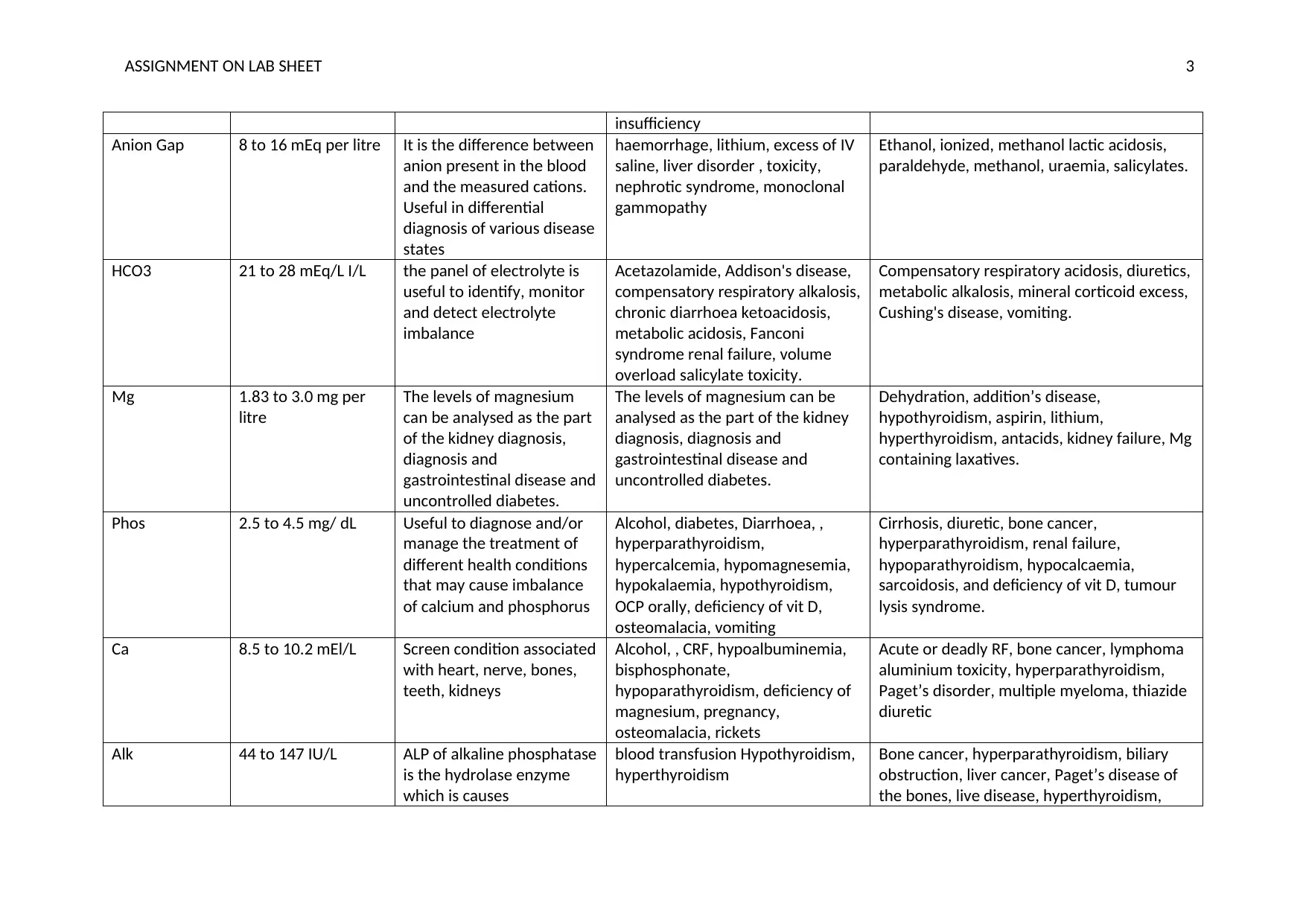
ASSIGNMENT ON LAB SHEET 3
insufficiency
Anion Gap 8 to 16 mEq per litre It is the difference between
anion present in the blood
and the measured cations.
Useful in differential
diagnosis of various disease
states
haemorrhage, lithium, excess of IV
saline, liver disorder , toxicity,
nephrotic syndrome, monoclonal
gammopathy
Ethanol, ionized, methanol lactic acidosis,
paraldehyde, methanol, uraemia, salicylates.
HCO3 21 to 28 mEq/L I/L the panel of electrolyte is
useful to identify, monitor
and detect electrolyte
imbalance
Acetazolamide, Addison's disease,
compensatory respiratory alkalosis,
chronic diarrhoea ketoacidosis,
metabolic acidosis, Fanconi
syndrome renal failure, volume
overload salicylate toxicity.
Compensatory respiratory acidosis, diuretics,
metabolic alkalosis, mineral corticoid excess,
Cushing's disease, vomiting.
Mg 1.83 to 3.0 mg per
litre
The levels of magnesium
can be analysed as the part
of the kidney diagnosis,
diagnosis and
gastrointestinal disease and
uncontrolled diabetes.
The levels of magnesium can be
analysed as the part of the kidney
diagnosis, diagnosis and
gastrointestinal disease and
uncontrolled diabetes.
Dehydration, addition’s disease,
hypothyroidism, aspirin, lithium,
hyperthyroidism, antacids, kidney failure, Mg
containing laxatives.
Phos 2.5 to 4.5 mg/ dL Useful to diagnose and/or
manage the treatment of
different health conditions
that may cause imbalance
of calcium and phosphorus
Alcohol, diabetes, Diarrhoea, ,
hyperparathyroidism,
hypercalcemia, hypomagnesemia,
hypokalaemia, hypothyroidism,
OCP orally, deficiency of vit D,
osteomalacia, vomiting
Cirrhosis, diuretic, bone cancer,
hyperparathyroidism, renal failure,
hypoparathyroidism, hypocalcaemia,
sarcoidosis, and deficiency of vit D, tumour
lysis syndrome.
Ca 8.5 to 10.2 mEl/L Screen condition associated
with heart, nerve, bones,
teeth, kidneys
Alcohol, , CRF, hypoalbuminemia,
bisphosphonate,
hypoparathyroidism, deficiency of
magnesium, pregnancy,
osteomalacia, rickets
Acute or deadly RF, bone cancer, lymphoma
aluminium toxicity, hyperparathyroidism,
Paget’s disorder, multiple myeloma, thiazide
diuretic
Alk 44 to 147 IU/L ALP of alkaline phosphatase
is the hydrolase enzyme
which is causes
blood transfusion Hypothyroidism,
hyperthyroidism
Bone cancer, hyperparathyroidism, biliary
obstruction, liver cancer, Paget’s disease of
the bones, live disease, hyperthyroidism,
insufficiency
Anion Gap 8 to 16 mEq per litre It is the difference between
anion present in the blood
and the measured cations.
Useful in differential
diagnosis of various disease
states
haemorrhage, lithium, excess of IV
saline, liver disorder , toxicity,
nephrotic syndrome, monoclonal
gammopathy
Ethanol, ionized, methanol lactic acidosis,
paraldehyde, methanol, uraemia, salicylates.
HCO3 21 to 28 mEq/L I/L the panel of electrolyte is
useful to identify, monitor
and detect electrolyte
imbalance
Acetazolamide, Addison's disease,
compensatory respiratory alkalosis,
chronic diarrhoea ketoacidosis,
metabolic acidosis, Fanconi
syndrome renal failure, volume
overload salicylate toxicity.
Compensatory respiratory acidosis, diuretics,
metabolic alkalosis, mineral corticoid excess,
Cushing's disease, vomiting.
Mg 1.83 to 3.0 mg per
litre
The levels of magnesium
can be analysed as the part
of the kidney diagnosis,
diagnosis and
gastrointestinal disease and
uncontrolled diabetes.
The levels of magnesium can be
analysed as the part of the kidney
diagnosis, diagnosis and
gastrointestinal disease and
uncontrolled diabetes.
Dehydration, addition’s disease,
hypothyroidism, aspirin, lithium,
hyperthyroidism, antacids, kidney failure, Mg
containing laxatives.
Phos 2.5 to 4.5 mg/ dL Useful to diagnose and/or
manage the treatment of
different health conditions
that may cause imbalance
of calcium and phosphorus
Alcohol, diabetes, Diarrhoea, ,
hyperparathyroidism,
hypercalcemia, hypomagnesemia,
hypokalaemia, hypothyroidism,
OCP orally, deficiency of vit D,
osteomalacia, vomiting
Cirrhosis, diuretic, bone cancer,
hyperparathyroidism, renal failure,
hypoparathyroidism, hypocalcaemia,
sarcoidosis, and deficiency of vit D, tumour
lysis syndrome.
Ca 8.5 to 10.2 mEl/L Screen condition associated
with heart, nerve, bones,
teeth, kidneys
Alcohol, , CRF, hypoalbuminemia,
bisphosphonate,
hypoparathyroidism, deficiency of
magnesium, pregnancy,
osteomalacia, rickets
Acute or deadly RF, bone cancer, lymphoma
aluminium toxicity, hyperparathyroidism,
Paget’s disorder, multiple myeloma, thiazide
diuretic
Alk 44 to 147 IU/L ALP of alkaline phosphatase
is the hydrolase enzyme
which is causes
blood transfusion Hypothyroidism,
hyperthyroidism
Bone cancer, hyperparathyroidism, biliary
obstruction, liver cancer, Paget’s disease of
the bones, live disease, hyperthyroidism,
Paraphrase This Document
Need a fresh take? Get an instant paraphrase of this document with our AI Paraphraser

ASSIGNMENT ON LAB SHEET 4
dephosphorylating of the
molecules like protein,
alkaloids, and nucleotides.
It is available in all the
tissues in each part of the
body, however it
specifically concentrated in
the liver, kidney, bone, bile
duct, and placenta
rickets, osteomalacia
Alt 10 to 35 IU/L Primarily related to the liver Deficiency of Vit B6 Acetaminophen toxicity, alcoholic hepatitis,
cholangitis, biliary obstruction,
choledocholithiasis, , liver cancer, liver
failure, mononucleosis, shock liver, liver
abscess non-alcoholic steatohepatitis
(NASH), , viral hepatitis
Ast Less than 35 IU/L Enzyme that related to the
cell damage in liver
parenchyma
Deficiency of vit B6 Acute viral hepatitis, , autoimmune hepatitis,
alcoholic hepatitis , cholangitis, ,
erythromycin, choledocholithiasis ,
hemochromatosis, liver abscess, Reye's
syndrome, liver cancer, myocardial
infarction, liver disease, Wilson's disease,
shock liver,.
Albumin Less than 0.4 mg/dl It is produced in liver and
various roles in maintaining
colloid osmotic pressure of
blood, movement of several
hydrophobic molecules like
hormones that are lipid
soluble, free fatty acids,
unconjugated bilirubin,
drugs, and bile salts
Burns, celiac sprue, chronic liver
disease, cirrhosis, Crohn's disease,
diabetes mellitus,
glomerulonephritis, hemodilution,
Hodgkin's lymphoma, infections,
inflammatory bowel disease,
leukaemia, malabsorption,
malnutrition, nephrotic syndrome,
multiple myeloma, pre-eclampsia,
oral contraceptive pills (OCP),
shock,, pregnancy, protein,
Shock, hemoconcentration, dehydration
dephosphorylating of the
molecules like protein,
alkaloids, and nucleotides.
It is available in all the
tissues in each part of the
body, however it
specifically concentrated in
the liver, kidney, bone, bile
duct, and placenta
rickets, osteomalacia
Alt 10 to 35 IU/L Primarily related to the liver Deficiency of Vit B6 Acetaminophen toxicity, alcoholic hepatitis,
cholangitis, biliary obstruction,
choledocholithiasis, , liver cancer, liver
failure, mononucleosis, shock liver, liver
abscess non-alcoholic steatohepatitis
(NASH), , viral hepatitis
Ast Less than 35 IU/L Enzyme that related to the
cell damage in liver
parenchyma
Deficiency of vit B6 Acute viral hepatitis, , autoimmune hepatitis,
alcoholic hepatitis , cholangitis, ,
erythromycin, choledocholithiasis ,
hemochromatosis, liver abscess, Reye's
syndrome, liver cancer, myocardial
infarction, liver disease, Wilson's disease,
shock liver,.
Albumin Less than 0.4 mg/dl It is produced in liver and
various roles in maintaining
colloid osmotic pressure of
blood, movement of several
hydrophobic molecules like
hormones that are lipid
soluble, free fatty acids,
unconjugated bilirubin,
drugs, and bile salts
Burns, celiac sprue, chronic liver
disease, cirrhosis, Crohn's disease,
diabetes mellitus,
glomerulonephritis, hemodilution,
Hodgkin's lymphoma, infections,
inflammatory bowel disease,
leukaemia, malabsorption,
malnutrition, nephrotic syndrome,
multiple myeloma, pre-eclampsia,
oral contraceptive pills (OCP),
shock,, pregnancy, protein,
Shock, hemoconcentration, dehydration
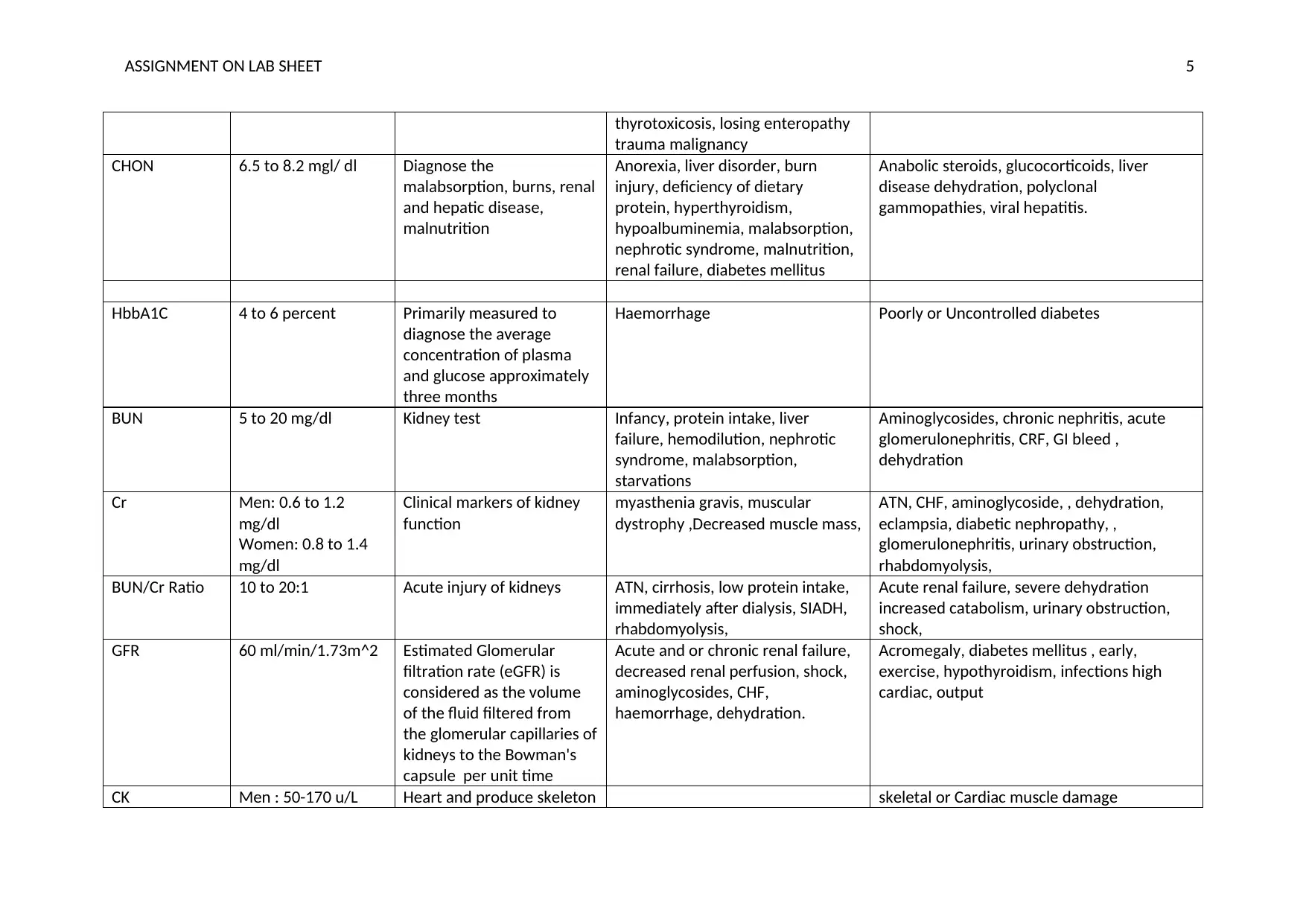
ASSIGNMENT ON LAB SHEET 5
thyrotoxicosis, losing enteropathy
trauma malignancy
CHON 6.5 to 8.2 mgl/ dl Diagnose the
malabsorption, burns, renal
and hepatic disease,
malnutrition
Anorexia, liver disorder, burn
injury, deficiency of dietary
protein, hyperthyroidism,
hypoalbuminemia, malabsorption,
nephrotic syndrome, malnutrition,
renal failure, diabetes mellitus
Anabolic steroids, glucocorticoids, liver
disease dehydration, polyclonal
gammopathies, viral hepatitis.
HbbA1C 4 to 6 percent Primarily measured to
diagnose the average
concentration of plasma
and glucose approximately
three months
Haemorrhage Poorly or Uncontrolled diabetes
BUN 5 to 20 mg/dl Kidney test Infancy, protein intake, liver
failure, hemodilution, nephrotic
syndrome, malabsorption,
starvations
Aminoglycosides, chronic nephritis, acute
glomerulonephritis, CRF, GI bleed ,
dehydration
Cr Men: 0.6 to 1.2
mg/dl
Women: 0.8 to 1.4
mg/dl
Clinical markers of kidney
function
myasthenia gravis, muscular
dystrophy ,Decreased muscle mass,
ATN, CHF, aminoglycoside, , dehydration,
eclampsia, diabetic nephropathy, ,
glomerulonephritis, urinary obstruction,
rhabdomyolysis,
BUN/Cr Ratio 10 to 20:1 Acute injury of kidneys ATN, cirrhosis, low protein intake,
immediately after dialysis, SIADH,
rhabdomyolysis,
Acute renal failure, severe dehydration
increased catabolism, urinary obstruction,
shock,
GFR 60 ml/min/1.73m^2 Estimated Glomerular
filtration rate (eGFR) is
considered as the volume
of the fluid filtered from
the glomerular capillaries of
kidneys to the Bowman's
capsule per unit time
Acute and or chronic renal failure,
decreased renal perfusion, shock,
aminoglycosides, CHF,
haemorrhage, dehydration.
Acromegaly, diabetes mellitus , early,
exercise, hypothyroidism, infections high
cardiac, output
CK Men : 50-170 u/L Heart and produce skeleton skeletal or Cardiac muscle damage
thyrotoxicosis, losing enteropathy
trauma malignancy
CHON 6.5 to 8.2 mgl/ dl Diagnose the
malabsorption, burns, renal
and hepatic disease,
malnutrition
Anorexia, liver disorder, burn
injury, deficiency of dietary
protein, hyperthyroidism,
hypoalbuminemia, malabsorption,
nephrotic syndrome, malnutrition,
renal failure, diabetes mellitus
Anabolic steroids, glucocorticoids, liver
disease dehydration, polyclonal
gammopathies, viral hepatitis.
HbbA1C 4 to 6 percent Primarily measured to
diagnose the average
concentration of plasma
and glucose approximately
three months
Haemorrhage Poorly or Uncontrolled diabetes
BUN 5 to 20 mg/dl Kidney test Infancy, protein intake, liver
failure, hemodilution, nephrotic
syndrome, malabsorption,
starvations
Aminoglycosides, chronic nephritis, acute
glomerulonephritis, CRF, GI bleed ,
dehydration
Cr Men: 0.6 to 1.2
mg/dl
Women: 0.8 to 1.4
mg/dl
Clinical markers of kidney
function
myasthenia gravis, muscular
dystrophy ,Decreased muscle mass,
ATN, CHF, aminoglycoside, , dehydration,
eclampsia, diabetic nephropathy, ,
glomerulonephritis, urinary obstruction,
rhabdomyolysis,
BUN/Cr Ratio 10 to 20:1 Acute injury of kidneys ATN, cirrhosis, low protein intake,
immediately after dialysis, SIADH,
rhabdomyolysis,
Acute renal failure, severe dehydration
increased catabolism, urinary obstruction,
shock,
GFR 60 ml/min/1.73m^2 Estimated Glomerular
filtration rate (eGFR) is
considered as the volume
of the fluid filtered from
the glomerular capillaries of
kidneys to the Bowman's
capsule per unit time
Acute and or chronic renal failure,
decreased renal perfusion, shock,
aminoglycosides, CHF,
haemorrhage, dehydration.
Acromegaly, diabetes mellitus , early,
exercise, hypothyroidism, infections high
cardiac, output
CK Men : 50-170 u/L Heart and produce skeleton skeletal or Cardiac muscle damage
⊘ This is a preview!⊘
Do you want full access?
Subscribe today to unlock all pages.

Trusted by 1+ million students worldwide

ASSIGNMENT ON LAB SHEET 6
women: 25-140 u/L enzyme
CKMB 0 to 6 percent CK-MB is the marker for the
cardiac ischemia the CKMB
rises nearly 5 hours after
MI, can peaks between
eighteen and 36 hours, and
remain elevated for 72
hours.
Differential
CKMM 94 to 100 % CK-MM, present primarily
in the skeletal muscle , the
predominant may form
Muscular dystrophy, trauma, vigorous
activity, and post op state
CK BB Zero percent CK-BB present inside the
brain
Acute injury in brain, CVA
TROPONIN I Less than 0.04 ng/
ml
Troponins are the proteins
of the cardiac muscle which
give the most specificity to
cardiac injury. Increased
Troponins may also have
the prognostic value in
which they are related to
the future adverse heart
related issues. Increase in
cTnI is the first seen five
hours after MI, peaks
between twenty four and
thirty six hours, and may
stay increased for weeks.
There are many different
assays for identifying cTnI,
therefore the reference
values can be vary widely
depending on the assay
which was used.
Differential Cardiac surgery, CHF, cardiac trauma, dilated
cardiomyopathy, prolonged SVT, myocardial
infarction, myocarditis, unstable angina.
women: 25-140 u/L enzyme
CKMB 0 to 6 percent CK-MB is the marker for the
cardiac ischemia the CKMB
rises nearly 5 hours after
MI, can peaks between
eighteen and 36 hours, and
remain elevated for 72
hours.
Differential
CKMM 94 to 100 % CK-MM, present primarily
in the skeletal muscle , the
predominant may form
Muscular dystrophy, trauma, vigorous
activity, and post op state
CK BB Zero percent CK-BB present inside the
brain
Acute injury in brain, CVA
TROPONIN I Less than 0.04 ng/
ml
Troponins are the proteins
of the cardiac muscle which
give the most specificity to
cardiac injury. Increased
Troponins may also have
the prognostic value in
which they are related to
the future adverse heart
related issues. Increase in
cTnI is the first seen five
hours after MI, peaks
between twenty four and
thirty six hours, and may
stay increased for weeks.
There are many different
assays for identifying cTnI,
therefore the reference
values can be vary widely
depending on the assay
which was used.
Differential Cardiac surgery, CHF, cardiac trauma, dilated
cardiomyopathy, prolonged SVT, myocardial
infarction, myocarditis, unstable angina.
Paraphrase This Document
Need a fresh take? Get an instant paraphrase of this document with our AI Paraphraser

ASSIGNMENT ON LAB SHEET 7
TROPONIN T Less than 0.01 ng per
ml
Similar to Trop I
TOTAL
CHOLESTEROL
Less than 200 mg per
dl
Cholesterol is the essential
lipid that available in the
membrane of the cell of all
the mammals. It is
transferred via blood
lipoproteins. It can play an
important role for the
membrane of the cell as it
works to manage their
fluidity
acute hepatitis, cirrhosis,
Abetalipoproteinemia,
hyperthyroidism, pernicious
anaemia, malnutrition and Tay
Sachs disease
Biliary cirrhosis, corticosteroids cholestasis,
familial hyperlipidaemias, Cushing’s
syndrome, , hyperlipidaemia, hepatocellular
carcinoma, increased dietary fat intake,
badly controlled diabetes type 2,
hypothyroidism, pregnancy, nephrotic
syndrome
LDL Less than 100 mg per
dl
LDL is considered on the
main groups of the
lipoprotein
Chronic disease,
Abetalipoproteinemia
Anabolic steroids, chronic kidney failure,
cholestasis, hypercholesterolemia, diabetes
mellitus, familial, nephrotic syndrome,
hypothyroidism, pregnancy, poor diet.
HDL Men: 45 to 90 mg
per dl
Women: 50 to 100
mg per dl
HDL is the main group of
lipoprotein
cigarette smoking Beta blockers,
diabetes mellitus chronic renal
failure, , hypothyroidism, diuretics,
low physical activity,, liver disease,
moderate alcohol metabolic
syndrome, oral contraceptive pills,
post-MI, obesity, uraemia, stress,
Therapy of oestrogen replacement, insulin,
exercise, phenytoin, phenobarbital.
TG Less than 150 mg per
dl
Heart risk factor; TG levels
may influenced highly by
the dietary consumption of
the fatty foods and
therefore triglycerides
levels will be varied all the
day that depends upon on
what an person eats
Hyperthyroidism, mal-absorption,
liver disease, malnutrition.
Alcohol, biliary
tract obstruction ,beta blockers,
, cigarette smoking, chronic kidney
failure, Corticosteroids,
cirrhosis, diuretics,
diabetes mellitus, ,
oestrogens, genetic
factors, fatty liver, hypothyroidism
TROPONIN T Less than 0.01 ng per
ml
Similar to Trop I
TOTAL
CHOLESTEROL
Less than 200 mg per
dl
Cholesterol is the essential
lipid that available in the
membrane of the cell of all
the mammals. It is
transferred via blood
lipoproteins. It can play an
important role for the
membrane of the cell as it
works to manage their
fluidity
acute hepatitis, cirrhosis,
Abetalipoproteinemia,
hyperthyroidism, pernicious
anaemia, malnutrition and Tay
Sachs disease
Biliary cirrhosis, corticosteroids cholestasis,
familial hyperlipidaemias, Cushing’s
syndrome, , hyperlipidaemia, hepatocellular
carcinoma, increased dietary fat intake,
badly controlled diabetes type 2,
hypothyroidism, pregnancy, nephrotic
syndrome
LDL Less than 100 mg per
dl
LDL is considered on the
main groups of the
lipoprotein
Chronic disease,
Abetalipoproteinemia
Anabolic steroids, chronic kidney failure,
cholestasis, hypercholesterolemia, diabetes
mellitus, familial, nephrotic syndrome,
hypothyroidism, pregnancy, poor diet.
HDL Men: 45 to 90 mg
per dl
Women: 50 to 100
mg per dl
HDL is the main group of
lipoprotein
cigarette smoking Beta blockers,
diabetes mellitus chronic renal
failure, , hypothyroidism, diuretics,
low physical activity,, liver disease,
moderate alcohol metabolic
syndrome, oral contraceptive pills,
post-MI, obesity, uraemia, stress,
Therapy of oestrogen replacement, insulin,
exercise, phenytoin, phenobarbital.
TG Less than 150 mg per
dl
Heart risk factor; TG levels
may influenced highly by
the dietary consumption of
the fatty foods and
therefore triglycerides
levels will be varied all the
day that depends upon on
what an person eats
Hyperthyroidism, mal-absorption,
liver disease, malnutrition.
Alcohol, biliary
tract obstruction ,beta blockers,
, cigarette smoking, chronic kidney
failure, Corticosteroids,
cirrhosis, diuretics,
diabetes mellitus, ,
oestrogens, genetic
factors, fatty liver, hypothyroidism
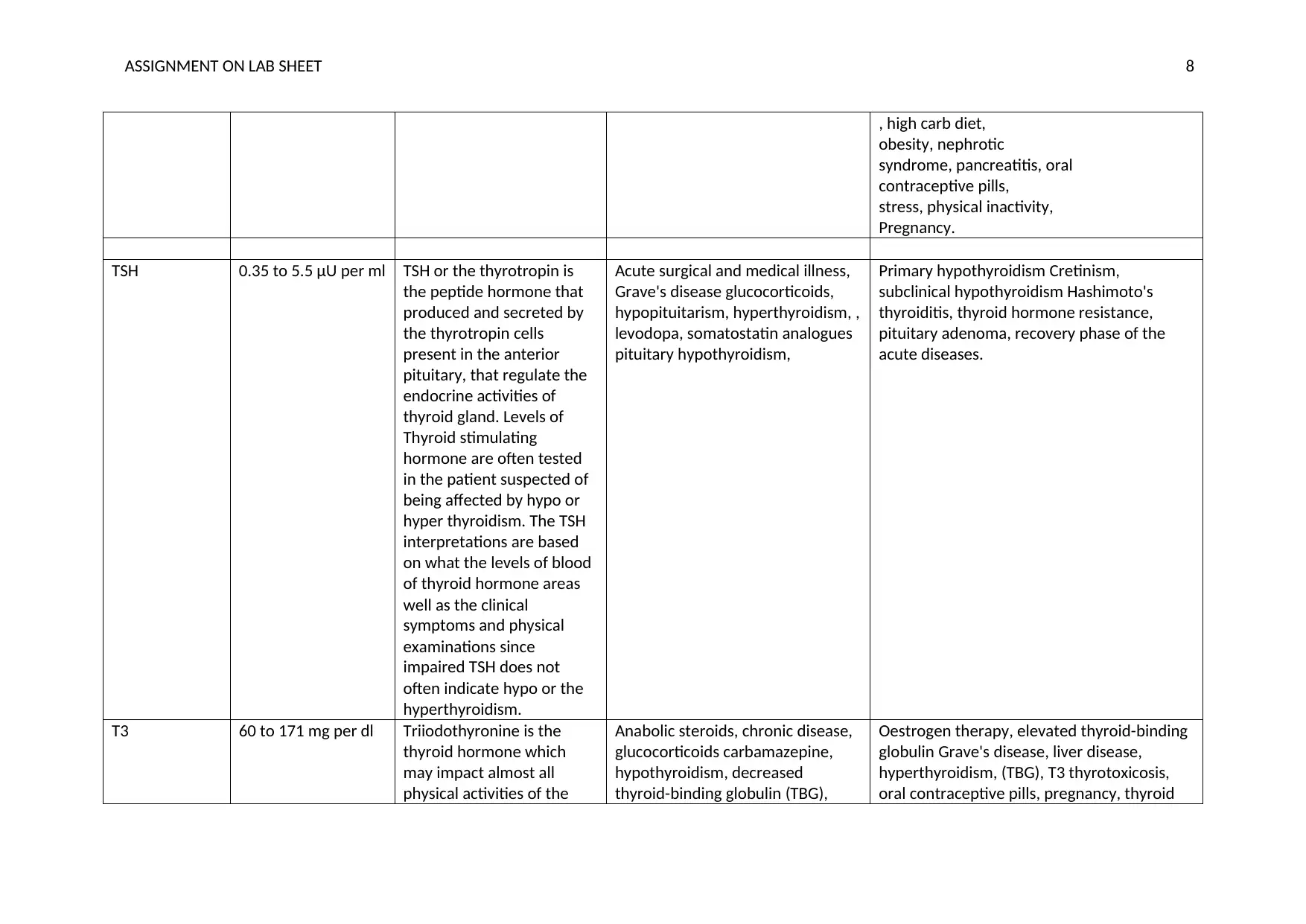
ASSIGNMENT ON LAB SHEET 8
, high carb diet,
obesity, nephrotic
syndrome, pancreatitis, oral
contraceptive pills,
stress, physical inactivity,
Pregnancy.
TSH 0.35 to 5.5 μU per ml TSH or the thyrotropin is
the peptide hormone that
produced and secreted by
the thyrotropin cells
present in the anterior
pituitary, that regulate the
endocrine activities of
thyroid gland. Levels of
Thyroid stimulating
hormone are often tested
in the patient suspected of
being affected by hypo or
hyper thyroidism. The TSH
interpretations are based
on what the levels of blood
of thyroid hormone areas
well as the clinical
symptoms and physical
examinations since
impaired TSH does not
often indicate hypo or the
hyperthyroidism.
Acute surgical and medical illness,
Grave's disease glucocorticoids,
hypopituitarism, hyperthyroidism, ,
levodopa, somatostatin analogues
pituitary hypothyroidism,
Primary hypothyroidism Cretinism,
subclinical hypothyroidism Hashimoto's
thyroiditis, thyroid hormone resistance,
pituitary adenoma, recovery phase of the
acute diseases.
T3 60 to 171 mg per dl Triiodothyronine is the
thyroid hormone which
may impact almost all
physical activities of the
Anabolic steroids, chronic disease,
glucocorticoids carbamazepine,
hypothyroidism, decreased
thyroid-binding globulin (TBG),
Oestrogen therapy, elevated thyroid-binding
globulin Grave's disease, liver disease,
hyperthyroidism, (TBG), T3 thyrotoxicosis,
oral contraceptive pills, pregnancy, thyroid
, high carb diet,
obesity, nephrotic
syndrome, pancreatitis, oral
contraceptive pills,
stress, physical inactivity,
Pregnancy.
TSH 0.35 to 5.5 μU per ml TSH or the thyrotropin is
the peptide hormone that
produced and secreted by
the thyrotropin cells
present in the anterior
pituitary, that regulate the
endocrine activities of
thyroid gland. Levels of
Thyroid stimulating
hormone are often tested
in the patient suspected of
being affected by hypo or
hyper thyroidism. The TSH
interpretations are based
on what the levels of blood
of thyroid hormone areas
well as the clinical
symptoms and physical
examinations since
impaired TSH does not
often indicate hypo or the
hyperthyroidism.
Acute surgical and medical illness,
Grave's disease glucocorticoids,
hypopituitarism, hyperthyroidism, ,
levodopa, somatostatin analogues
pituitary hypothyroidism,
Primary hypothyroidism Cretinism,
subclinical hypothyroidism Hashimoto's
thyroiditis, thyroid hormone resistance,
pituitary adenoma, recovery phase of the
acute diseases.
T3 60 to 171 mg per dl Triiodothyronine is the
thyroid hormone which
may impact almost all
physical activities of the
Anabolic steroids, chronic disease,
glucocorticoids carbamazepine,
hypothyroidism, decreased
thyroid-binding globulin (TBG),
Oestrogen therapy, elevated thyroid-binding
globulin Grave's disease, liver disease,
hyperthyroidism, (TBG), T3 thyrotoxicosis,
oral contraceptive pills, pregnancy, thyroid
⊘ This is a preview!⊘
Do you want full access?
Subscribe today to unlock all pages.

Trusted by 1+ million students worldwide
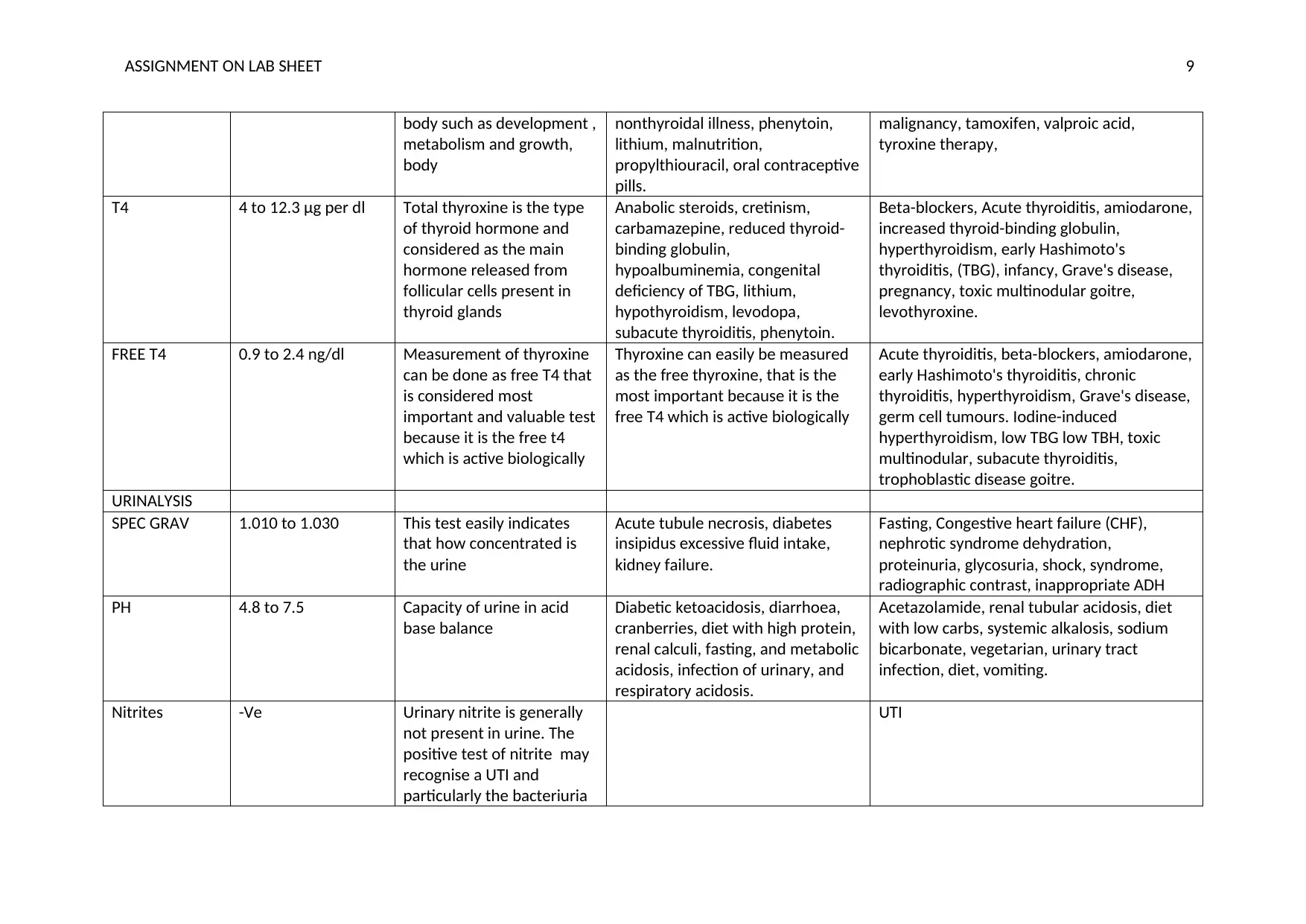
ASSIGNMENT ON LAB SHEET 9
body such as development ,
metabolism and growth,
body
nonthyroidal illness, phenytoin,
lithium, malnutrition,
propylthiouracil, oral contraceptive
pills.
malignancy, tamoxifen, valproic acid,
tyroxine therapy,
T4 4 to 12.3 μg per dl Total thyroxine is the type
of thyroid hormone and
considered as the main
hormone released from
follicular cells present in
thyroid glands
Anabolic steroids, cretinism,
carbamazepine, reduced thyroid-
binding globulin,
hypoalbuminemia, congenital
deficiency of TBG, lithium,
hypothyroidism, levodopa,
subacute thyroiditis, phenytoin.
Beta-blockers, Acute thyroiditis, amiodarone,
increased thyroid-binding globulin,
hyperthyroidism, early Hashimoto's
thyroiditis, (TBG), infancy, Grave's disease,
pregnancy, toxic multinodular goitre,
levothyroxine.
FREE T4 0.9 to 2.4 ng/dl Measurement of thyroxine
can be done as free T4 that
is considered most
important and valuable test
because it is the free t4
which is active biologically
Thyroxine can easily be measured
as the free thyroxine, that is the
most important because it is the
free T4 which is active biologically
Acute thyroiditis, beta-blockers, amiodarone,
early Hashimoto's thyroiditis, chronic
thyroiditis, hyperthyroidism, Grave's disease,
germ cell tumours. Iodine-induced
hyperthyroidism, low TBG low TBH, toxic
multinodular, subacute thyroiditis,
trophoblastic disease goitre.
URINALYSIS
SPEC GRAV 1.010 to 1.030 This test easily indicates
that how concentrated is
the urine
Acute tubule necrosis, diabetes
insipidus excessive fluid intake,
kidney failure.
Fasting, Congestive heart failure (CHF),
nephrotic syndrome dehydration,
proteinuria, glycosuria, shock, syndrome,
radiographic contrast, inappropriate ADH
PH 4.8 to 7.5 Capacity of urine in acid
base balance
Diabetic ketoacidosis, diarrhoea,
cranberries, diet with high protein,
renal calculi, fasting, and metabolic
acidosis, infection of urinary, and
respiratory acidosis.
Acetazolamide, renal tubular acidosis, diet
with low carbs, systemic alkalosis, sodium
bicarbonate, vegetarian, urinary tract
infection, diet, vomiting.
Nitrites -Ve Urinary nitrite is generally
not present in urine. The
positive test of nitrite may
recognise a UTI and
particularly the bacteriuria
UTI
body such as development ,
metabolism and growth,
body
nonthyroidal illness, phenytoin,
lithium, malnutrition,
propylthiouracil, oral contraceptive
pills.
malignancy, tamoxifen, valproic acid,
tyroxine therapy,
T4 4 to 12.3 μg per dl Total thyroxine is the type
of thyroid hormone and
considered as the main
hormone released from
follicular cells present in
thyroid glands
Anabolic steroids, cretinism,
carbamazepine, reduced thyroid-
binding globulin,
hypoalbuminemia, congenital
deficiency of TBG, lithium,
hypothyroidism, levodopa,
subacute thyroiditis, phenytoin.
Beta-blockers, Acute thyroiditis, amiodarone,
increased thyroid-binding globulin,
hyperthyroidism, early Hashimoto's
thyroiditis, (TBG), infancy, Grave's disease,
pregnancy, toxic multinodular goitre,
levothyroxine.
FREE T4 0.9 to 2.4 ng/dl Measurement of thyroxine
can be done as free T4 that
is considered most
important and valuable test
because it is the free t4
which is active biologically
Thyroxine can easily be measured
as the free thyroxine, that is the
most important because it is the
free T4 which is active biologically
Acute thyroiditis, beta-blockers, amiodarone,
early Hashimoto's thyroiditis, chronic
thyroiditis, hyperthyroidism, Grave's disease,
germ cell tumours. Iodine-induced
hyperthyroidism, low TBG low TBH, toxic
multinodular, subacute thyroiditis,
trophoblastic disease goitre.
URINALYSIS
SPEC GRAV 1.010 to 1.030 This test easily indicates
that how concentrated is
the urine
Acute tubule necrosis, diabetes
insipidus excessive fluid intake,
kidney failure.
Fasting, Congestive heart failure (CHF),
nephrotic syndrome dehydration,
proteinuria, glycosuria, shock, syndrome,
radiographic contrast, inappropriate ADH
PH 4.8 to 7.5 Capacity of urine in acid
base balance
Diabetic ketoacidosis, diarrhoea,
cranberries, diet with high protein,
renal calculi, fasting, and metabolic
acidosis, infection of urinary, and
respiratory acidosis.
Acetazolamide, renal tubular acidosis, diet
with low carbs, systemic alkalosis, sodium
bicarbonate, vegetarian, urinary tract
infection, diet, vomiting.
Nitrites -Ve Urinary nitrite is generally
not present in urine. The
positive test of nitrite may
recognise a UTI and
particularly the bacteriuria
UTI
Paraphrase This Document
Need a fresh take? Get an instant paraphrase of this document with our AI Paraphraser
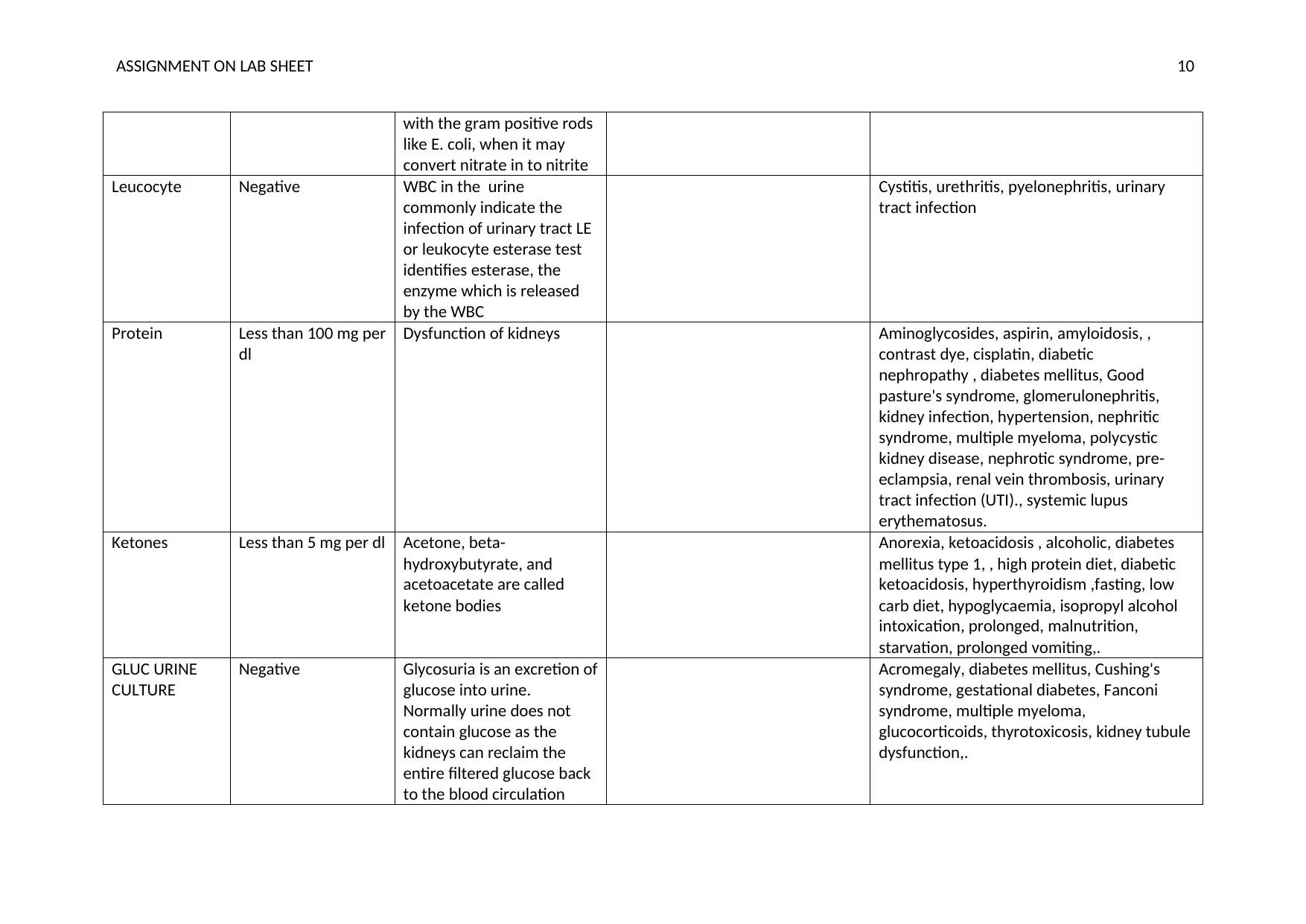
ASSIGNMENT ON LAB SHEET 10
with the gram positive rods
like E. coli, when it may
convert nitrate in to nitrite
Leucocyte Negative WBC in the urine
commonly indicate the
infection of urinary tract LE
or leukocyte esterase test
identifies esterase, the
enzyme which is released
by the WBC
Cystitis, urethritis, pyelonephritis, urinary
tract infection
Protein Less than 100 mg per
dl
Dysfunction of kidneys Aminoglycosides, aspirin, amyloidosis, ,
contrast dye, cisplatin, diabetic
nephropathy , diabetes mellitus, Good
pasture's syndrome, glomerulonephritis,
kidney infection, hypertension, nephritic
syndrome, multiple myeloma, polycystic
kidney disease, nephrotic syndrome, pre-
eclampsia, renal vein thrombosis, urinary
tract infection (UTI)., systemic lupus
erythematosus.
Ketones Less than 5 mg per dl Acetone, beta-
hydroxybutyrate, and
acetoacetate are called
ketone bodies
Anorexia, ketoacidosis , alcoholic, diabetes
mellitus type 1, , high protein diet, diabetic
ketoacidosis, hyperthyroidism ,fasting, low
carb diet, hypoglycaemia, isopropyl alcohol
intoxication, prolonged, malnutrition,
starvation, prolonged vomiting,.
GLUC URINE
CULTURE
Negative Glycosuria is an excretion of
glucose into urine.
Normally urine does not
contain glucose as the
kidneys can reclaim the
entire filtered glucose back
to the blood circulation
Acromegaly, diabetes mellitus, Cushing's
syndrome, gestational diabetes, Fanconi
syndrome, multiple myeloma,
glucocorticoids, thyrotoxicosis, kidney tubule
dysfunction,.
with the gram positive rods
like E. coli, when it may
convert nitrate in to nitrite
Leucocyte Negative WBC in the urine
commonly indicate the
infection of urinary tract LE
or leukocyte esterase test
identifies esterase, the
enzyme which is released
by the WBC
Cystitis, urethritis, pyelonephritis, urinary
tract infection
Protein Less than 100 mg per
dl
Dysfunction of kidneys Aminoglycosides, aspirin, amyloidosis, ,
contrast dye, cisplatin, diabetic
nephropathy , diabetes mellitus, Good
pasture's syndrome, glomerulonephritis,
kidney infection, hypertension, nephritic
syndrome, multiple myeloma, polycystic
kidney disease, nephrotic syndrome, pre-
eclampsia, renal vein thrombosis, urinary
tract infection (UTI)., systemic lupus
erythematosus.
Ketones Less than 5 mg per dl Acetone, beta-
hydroxybutyrate, and
acetoacetate are called
ketone bodies
Anorexia, ketoacidosis , alcoholic, diabetes
mellitus type 1, , high protein diet, diabetic
ketoacidosis, hyperthyroidism ,fasting, low
carb diet, hypoglycaemia, isopropyl alcohol
intoxication, prolonged, malnutrition,
starvation, prolonged vomiting,.
GLUC URINE
CULTURE
Negative Glycosuria is an excretion of
glucose into urine.
Normally urine does not
contain glucose as the
kidneys can reclaim the
entire filtered glucose back
to the blood circulation
Acromegaly, diabetes mellitus, Cushing's
syndrome, gestational diabetes, Fanconi
syndrome, multiple myeloma,
glucocorticoids, thyrotoxicosis, kidney tubule
dysfunction,.

ASSIGNMENT ON LAB SHEET 11
Osmolality 50=1200 mOsm/kg Osmolality of urine is
basically measuring the
particles that osmotically
active in the urine and it is
helpful in identifying the
diluting and concentrating
ability of both kidneys
Acute renal failure, antipsychotic,
antidepressants, bromocriptine,
excess fluid ingestion, diabetes
insipidus, hypokalaemia,
hyperaldosteronism, renal tubule
necrosis, and lithium.
Addison's disease, dehydration, congestive
heart failure (CHF), glycosuria, prerenal
azotaemia, SIADH, diet with high protein,
shock.
Stool study
Cultures Negative To examine the type of
micro-organism are there in
the digestive system
C-dif
O & P Negative Rule out infection of
parasite
Positive parasite Ova infestation
Faecal
leukocytes
Negative Bacterial invasion may
causes damage to the
tissues
Amebiasis, Salmonellosis and shigellosis
Blood Cx Negative Recognising the pathogen
in the blood
Blood gases
pH 7.35 to 7.45 pH is basically the
measurement of acid base
balance in the blood
Respiratory acidosis, metabolic
acidosis
Respiratory alkalosis, metabolic alkalosis
PO2 75 to 105 mmHg PaO2 measurement
indicates the total amount
of O2 in the blood
Alcohol, asthma, airway
obstruction, benzodiazepines,
barbiturates, COPD, congenital
heart disease, interstitial lung
disorder, Guillian-Barre syndrome,
pneumonia, pulmonary embolism,
ventilation-perfusion mismatch,
Myasthenia gravis.
Oxygen assistance
Osmolality 50=1200 mOsm/kg Osmolality of urine is
basically measuring the
particles that osmotically
active in the urine and it is
helpful in identifying the
diluting and concentrating
ability of both kidneys
Acute renal failure, antipsychotic,
antidepressants, bromocriptine,
excess fluid ingestion, diabetes
insipidus, hypokalaemia,
hyperaldosteronism, renal tubule
necrosis, and lithium.
Addison's disease, dehydration, congestive
heart failure (CHF), glycosuria, prerenal
azotaemia, SIADH, diet with high protein,
shock.
Stool study
Cultures Negative To examine the type of
micro-organism are there in
the digestive system
C-dif
O & P Negative Rule out infection of
parasite
Positive parasite Ova infestation
Faecal
leukocytes
Negative Bacterial invasion may
causes damage to the
tissues
Amebiasis, Salmonellosis and shigellosis
Blood Cx Negative Recognising the pathogen
in the blood
Blood gases
pH 7.35 to 7.45 pH is basically the
measurement of acid base
balance in the blood
Respiratory acidosis, metabolic
acidosis
Respiratory alkalosis, metabolic alkalosis
PO2 75 to 105 mmHg PaO2 measurement
indicates the total amount
of O2 in the blood
Alcohol, asthma, airway
obstruction, benzodiazepines,
barbiturates, COPD, congenital
heart disease, interstitial lung
disorder, Guillian-Barre syndrome,
pneumonia, pulmonary embolism,
ventilation-perfusion mismatch,
Myasthenia gravis.
Oxygen assistance
⊘ This is a preview!⊘
Do you want full access?
Subscribe today to unlock all pages.

Trusted by 1+ million students worldwide
1 out of 17
Your All-in-One AI-Powered Toolkit for Academic Success.
+13062052269
info@desklib.com
Available 24*7 on WhatsApp / Email
![[object Object]](/_next/static/media/star-bottom.7253800d.svg)
Unlock your academic potential
Copyright © 2020–2025 A2Z Services. All Rights Reserved. Developed and managed by ZUCOL.